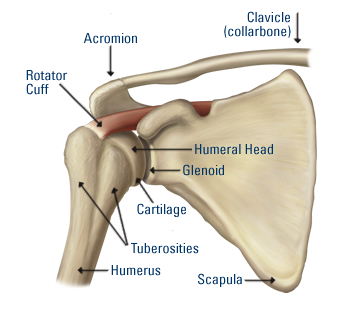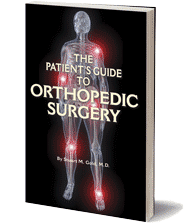Shoulder Surgery - Pain, Joint Replacement & Treatment
By Dr. Stuart Gold, M.D., Orthopedic Surgeon & Author
The shoulder is one of the most diverse joints in the human body. It permits the arm to be rotated, elevated, and extended both forward and backward. This very flexibility means that it is also one of the most unstable joints, making it prone to injury and shoulder surgery.

A ball-and-socket style joint, the shoulder consists of three bones. The humerus is the bone in the upper arm, the scapula is commonly known as the shoulder blade, and the clavicle is often referred to as the collarbone. The humerus has a ball on its end that fits into a socket on the scapula. The scapula is connected to the shoulder at one end and the sternum at its other end. Surrounding the joint is a network of muscles and tendons that enable a wide range of motion.
Shoulder Surgery Due To Overuse, Injury and Pain
Many injuries to the shoulder come from overuse or injury. Tendonitis can result from overtaxing the joint through repetitive movements -- which may occur during certain sports or work functions. The rotator cuff can become squeezed or impinged, resulting in pain. Typically, non-surgical treatments are recommended and attempted first. Tears to the rotator cuff may be treated with medication and therapy. If these non-invasive therapies do not reduce patient pain, shoulder surgery may be necessary. In certain cases, delayed treatment can sometimes make the problem much more difficult to repair later. It is therefore important that all shoulder injuries be taken seriously and that the correct diagnosis and plan of treatment be followed.
With injury or overuse, the ball on the humerus can be dislocated, either completely or partially (unstable), from the socket. In some patients, the shoulder manifests an instability that makes repeated dislocations common. Shoulder surgery may be required to address the problem. Depending on the patient, open surgery or arthroscopic surgery may be chosen. Both types of surgery usually involve physical therapy or rehabilitation to restore maximum strength and flexibility.
 Dr. Stuart Gold, M.D. With Shoulder Surgery Patient
Dr. Stuart Gold, M.D. With Shoulder Surgery Patient
Children and older patients may need surgery to repair severe fractures of the collarbone or of the humerus near the top of the bone. In the event that the humerus is dislocated or fragmented, an artificial joint may need be implanted to replace the damaged area. This procedure is most commonly required as a result of a fall incurred by an older patient with osteoporosis. Shoulder replacement surgery may also be recommended for arthritis patients who are suffering from painful or limited mobility.
Types of Shoulder Surgery Treatment
Orthopedic surgeons typically perform two types of surgery, with the decision based on the circumstances of each patient case.
- The least invasive type is arthroscopic surgery. A small incision is made and a tiny imaging device is inserted. The pictures are shown on a monitor. If the condition can be remedied with this type of surgery, instruments can be introduced through the incision to perform the surgery. Often, arthroscopic surgery can be performed as an outpatient procedure.
- Open surgery involves a larger incision and more traditional surgical tools. Improvements in recent years have enabled surgeons to reduce the size of the incision in many cases.
 Dr. Stuart Gold, M.D. Performs Shoulder Arthroscopy
Dr. Stuart Gold, M.D. Performs Shoulder Arthroscopy
Complications & Risks Of Shoulder Surgery
Both types of shoulder surgery carry the risk of complications. Infection is always a concern in any type of surgery. There is also the risk, however rare, that blood vessels and nerves can be damaged during the operation. While some tenderness, pain or stiffness is to be expected following surgery, patients should report any fever, increased swelling or pain, tingling or numbness in the hand or arm, excessive bleeding, or tenderness, warmth, or redness around the incision.
Shoulder surgery normally requires patients to complete a program of therapy or exercise to stretch and strengthen the muscles around the joint. Studies show that those who fail to comply have more pain and less mobility, which may worsen over time and become permanent. This problem is referred to as post operative capsulitis, commonly known as a ‘frozen shoulder’. Some procedures, such as surgery to repair a full rotator cuff tear, require extensive rehabilitative therapy to restore normal functionality to the shoulder.
> To learn more about shoulder pain, diagnosis and treatment, please click here.



